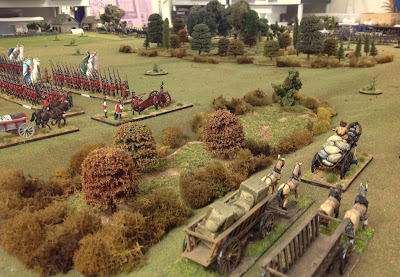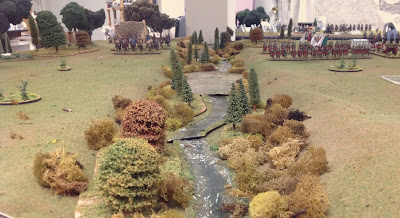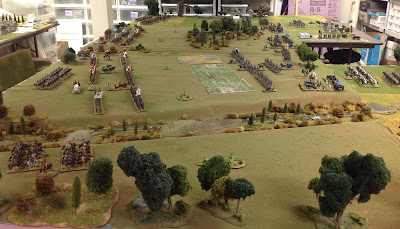 |
| A battery of German 88s deployed behind a sand dune. l. |
This past weekend I played in my first WW2 wargame ever, not counting HO figures that I played with in my sandbox as a kid. The battle was set in North Africa in 1942. We were using 15mm tanks and equipment played on a long table measuring about 6ft wide by 15ft long, so there was a lot of maneuvering room to work with. The rules used were a house variation of Blitzkrieg Commander II. I found that the rules were relatively easy to grasp, so that helped to overcome some of my trepidation about playing a game in something other than the black powder horse and musket era.
Because I had a box full of German Mark III tanks and a couple of big "You Know Whats" that I had never played with, our host, Bill P. let me play on the German team.
You know the old saying, "if you are playing in a poker game and trying to figure out who is the mark then it is probably you." That was easy to figure out - the chump was undoubtedly me since I knew next to nothing about WW2 tactics.
So I went into the game with something less than a peaceful easy feeling about my play in the game.
This game report is more about the ebb and flow of morale in a wargame. I'm not talking about the morale of the Little Men on the table, but rather, the morale of the players in the game. There are some interesting dynamics going on from that perspective.
The Scenario
It went something like this: there was a town in the middle of nowhere call Sidi El Something Or Other (the names are not important when you are just learning the ropes). The town was at a crossroads. The Germans and their Italian allies were approaching from the south (I just made that up) and they had to make a right turn at the town and exit the table. There were three ridges going across the width of the table and they were widely spaced out so that they could easily hide those naer do well British Tommies.
 |
| A view of Sidi El Something Or Other and some of those cute little Harringtons comming towards ME. The middle ridge is to the left of the town, the far ridge is off in the distance where the road leads to the next village. I have already passed the ridge that was hiding the Germans. |
Let the Game Begin - the Recon Phase
The game started with four turns of reconnaisance, with cute little Marmon Harringtons and German Pskvxkzrt 's (that is, the vehicles had long names without any vowels). I have no idea what they are called, but they seemed to scoot around the desert and they had a little pop gun of a cannon that couldn't hit anything.
The Italian scout vehicles entered the table on the left and my two German Volkswagens scooted across the table on the right. The spotting rules were easy to learn and soon we had a little game of cat and mouse as the British scurried hither and yon. I figured that there was probably something big, mean and bad on the other side of the central ridgeline on the table. (Gee, you think?).
 |
| My Vowel-less VW zips across the sand and raises a dust cloud. In the upper left corner you can just barely see the yellow ochre colored Italian Ferrari scout vehicles heading towards the middle ridge to see what is on the other side of the hill. |
After four turns of recon, the clank of treads was heard and large clouds of dust were seen on the horizan as Big Armor came rumbling onto the table for both teams. At this point, the real game would start and so we got down to the business of moving our vehicles and trying to exit the table.
 |
| The British scout cars put it in reverse and lay a patch. Was it something that they saw or was it tea time in the Sidi? |
 |
This is what the Harringtons saw rumbling down the road trying to loosen their load.
Seeing those panzers really lifted my morale, to say the least. |
At this point in the game, my personal morale was pretty good because I hadn't been blown up yet and a passle of panzers was coming up behind me in support.
It's Clobberin' Time!
So things were looking wonderbar on my side of the table (the right) and the Italians were helpful as they made a bee-line for the central ridge. They were chasing a couple of British Harringtons back towards the town. The Italians crested the ridge (come on, you know what is going to happen) and watched as two big dust clouds headed their way.
To their left were a few small Grants, but to their right was a platoon of some Big Nasties, Chieftans I think. I heard a lot of big booms and pops to my left, but paid them little heed as the tune Alte Kommeraden played in my head as I watch four Mark III and one awesome looking Tiger (I know, but its just a game and you bring what ya got, right?).
The booms and pops turned into a rising mushroom cloud of flame and smoke as one after another, the Italian tanks started blowing up. I looked over at my Italian ally and I could see that his personal morale was heading south after that ugly encounter with British armor. I am certain that the British players detected the shift in Italian morale as they came rumbling over the hill to give chase. Doesn't anyone learn anything?
To my immediate front, this is what I saw! I flatter myself to thing that they were coming for me!
 |
| A bunch of nasty looking British tanks come out of hiding and block the Germans' exit road. Oh fiddlesticks. |
What ho! The British were more interested in the German panzers than they were with me and my little VWs. My morale level was dialed in at "Relief".
 |
| An aerial view from a German Stuka shows the German ridge and a platoon of tanks on the road. |
One thing that you learn in a wargame is that when the Big Guys are going at it with one another, the Little Guys had best get out of the way. One of my Volkswagens was caught in the middle and blew up in the ensuing tank fight. My other scout car, probably an Audi or something fast, decided that the safest place on the board was in downtown Side El Something Or Other. So I headed into town and nobody paid me heed as I hid out in Rick's Cafe until the fighting settled down.
Payback Time!
Undoubtedly the morale of the British Chieftans was sky high as they followed the Italian armor over the central ridge. Then they saw a sight that probably soiled their trousers:
 |
| I deployed my tank platoon in front of the German ridge and set up a pair of 88s behind the sand dune. Mwahahaha! |
Yes, I had just deployed my platoon of Mark IIIs on the other side of the central ridge and was warming up the 0le 88s for good measuring. My personal morale was about to go sky high.
 |
| It's a beautiful thing if you are a German... |
Even with the Chieftans hull down on the central ridge, the whole platoon got blown to bits by the weight of all of The Krupp Works best munitions. I watched as one tank after another blew up and erupted into fireballs - five times!
 |
...not quite so if you are the British though.
The remnants of the Italian tanks can be seen burning in the background while those of the British, in the foreground, are billowing black smoke. Their day is done. |
Now I'm sure that the personal morale of the British tank commander had to be at its nadir. Mine would if I were in his boots. However, he put on a brave face and didn't show any signs of being downcast. This is a good point to make and a teachable moment - never let your opponent see your morale going down. Kudos to the British player on this score.
A Comical Interlude
The British decided that the time was ripe to unleash the RAF onto the line of German panzers, all eight of them at the moment, all sitting pretty on the ridge.
 |
| An RAF Hurricane draws a bead on the German tank line. |
My memory of this is rather hazy, but I think that the RAF managed to take only one German tank out of play. The flyboys missed everything on their first pass, but their aim improved enough on the second pass to knock out one of our panzers.
I should point out that there was a second Hurricane, but it couldn't get off of the ground for at least two turns. It finally experienced liftoff on the third attempt, but the pilot's Mr. Magoo Myopia kept him from hitting any targets. We named him, Eddie the Eagle.
We Were Getting A Little Too Full of Ourselves
At this point in the game, the British were on the run all across the desert. The two British heavy tank platoons lost 9 of their 10 tanks (all 5 on the ridge, and the other 4 that were guarding the exit road near the Sidi. Two of the light Grants were also out of action and skedaddling over the far ridge.
So what does a good cocky German tank commander do in this situation? Why pull an Elmer Fudd of course and chase Bugs Bunny back over the central ridge.
 |
| Here come my four remaining Mark IIIs emerging from the smoke and ruins in pursuit. Sort of reminds of the scene in Animal House when the badass car emerges from the smoke to inflict havor on the parade. |
 |
| The Italians were feeling pretty good too. You can see them in the background on the right as they too rumble towards the ridge where Glory awaits us all. |
There is another old saying (I love old sayings) that "when something is too good to be true, it IS too good to be true." My personal morale is insanely high at this point, afterall, I put a can of whoopin' on the British tanks and I had a couple more cans yet to give away.
Well not so fast there Ace.
Boom Boom, Out Go the Lights
As I was emerging through the smoke of the burging Chieftans on the central ridge, I looked through my binoculars at the little village on the last ridge and saw a little man in a khaki peaked cap, sitting on the roof of a mud house, and he was waving to me and laughing.
Insolent little pup, I thought to myself. What could be so funny. I was about to find out:
 |
| Um, uh what happened. Egads! That's my panzer platoon going up in smoke. |
In short order, a barrage of explosive shell came over the hills from far away and landed smack dab in the middle of my panzer formation. Italians to the left of me, little Harringtons to the right, here I am stuck in the middle with you!
The vehicle of my destruction was not the Stay Puffed Marshmellow Man, but rather a full battery of five big old ugly Royal Horse Artillery 25 pounders.
 |
| This is what happened to me. Looks like every single British artillery piece in North Africa. |
 |
| If you go out in the desert on day and see these guys, then kiss your derrierre goodbye. |
My command was wiped out, save for one Mark III, but it was not allowed to move on the next turn because my command vehicle was also a smoking ruin.
My personal morale was totally shot to pieces, just like my tanks. Sweet Baby Onions, I thought, what the heck just happened to me?!!!
Well, here is what happened; that little man in the peaked cap was an artillery spotter and he was calling in the barrage on me.
 |
My tank command after getting pounded by British artillery - three times.
(image is of the Highway of Death in the Gulf War in 1991) |
What did I learn from all of this?
Well a couple of things actually; first, it is always a good idea to find out what is on the other side of the hill before you go wandreing over; and second, whenever you see a single little man with a pair of binoculars in his hands, you had best train all of your guns on him before he calls in an artillery barrage on top of you.
There is another lesson of sorts to be gleaned from all of this, and that is just as there can be an ebb and flow in a wargame, so too can our personal morale shift up and down during the course of the game. It is best not to get too high or too low in your personal morale. Don't be visibly too happy when the game goes your way because you can bet your bottom dollar that the weather vane will eventually turn against you in the same game. It is important how we wear our emotions and our morale.
At the end of the day, I had a good time playing WW2 for the first time. It was not too technical as I had feared. I had some early success and I also got clobbered. I was expecting the clobbering before the start of the game so I came out of it better than I had thought possible.
I think that we all had a good time playing this game - a good host, good food and amiable players all add up to a good day. Here is a post game picture of our band of brothers
 |
Bad Guys: Jim P. (me), Michael M., and John B.
The Good Guys: Keith J., Bill P. and Bob M. |
Undoubtedly I misnamed or misidentified most of the tanks and equipment used in the game, so no corrections please. LOL.




















































